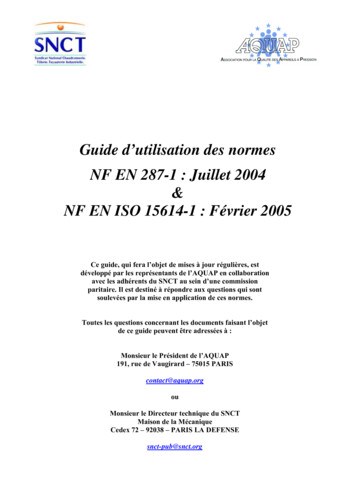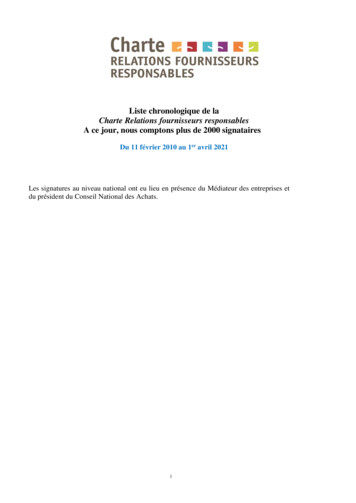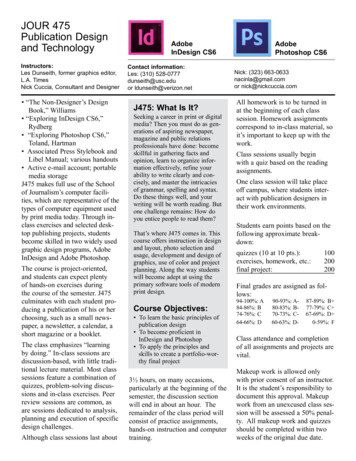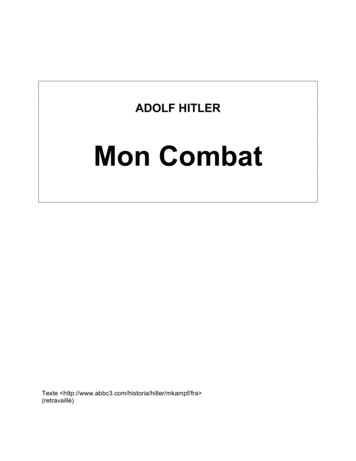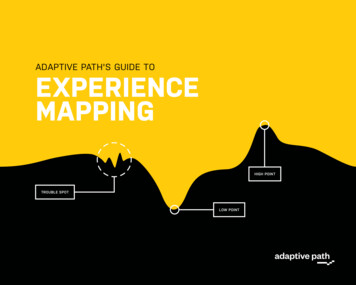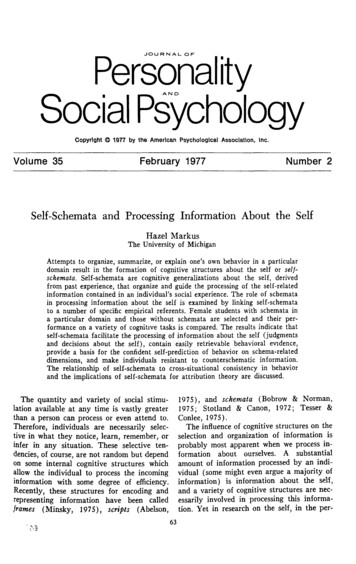
Transcription
JOUR N ALOFPersonalitySocial PsychologyCopyright 1977 by the American Psychological Association, Inc.Volume 35February 1977Number 2Self-Schemata and Processing Information About the SelfHazel MarkusThe University of MichiganAttempts to organize, summarize, or explain one's own behavior in a particulardomain result in the formation of cognitive structures about the self or selfschemata. Self-schemata are cognitive generalizations about the self, derivedfrom past experience, that organize and guide the processing of the self-relatedinformation contained in an individual's social experience. The role of schematain processing information about the self is examined by linking self-schematato a number of specific empirical referents. Female students with schemata ina particular domain and those without schemata are selected and their performance on a variety of cognitive tasks is compared. The results indicate thatself-schemata facilitate the processing of information about the self (judgmentsand decisions about the self), contain easily retrievable behavioral evidence,provide a basis for the confident self-prediction of behavior on schema-relateddimensions, and make individuals resistant to counterschematic information.The relationship of self-schemata to cross-situational consistency in behaviorand the implications of self-schemata for attribution theory are discussed.1975), and schemata (Bobrow & Norman,1975; Stotland & Canon, 1972; Tesser &Conlee, 1975).The influence of cognitive structures on theselection and organization of information isprobably most apparent when we process information about ourselves. A substantialamount of information processed by an individual (some might even argue a majority ofinformation) is information about the self,and a variety of cognitive structures are necessarily involved in processing this information. Yet in research on the self, in the per-The quantity and variety of social stimulation available at any time is vastly greaterthan a person can process or even attend to.Therefore, individuals are necessarily selective in what they notice, learn, remember, orinfer in any situation. These selective tendencies, of course, are not random but dependon some internal cognitive structures whichallow the individual to process the incominginformation with some degree of efficiency.Recently, these structures for encoding andrepresenting information have been calledframes (Minsky, 1975), scripts (Abelson,63
64HAZEL MARKUSsonality area for example, there has been anotable lack of attention to the structuresused in encoding one's own behavior and inthe processing of information about one'sown behavior. Research on self-perception(Bern, 1967, 1972) and research on selfmonitoring (Snyder, 1974; Snyder & Monson, 1975) clearly suggests that the individualis an active, constructive information processor, but no specific cognitive structures haveyet been implicated in this theorizing andresearch.It is proposed here that attempts to organize, summarize, or explain one's own behavior in a particular domain will result inthe formation of cognitive structures aboutthe self or what might be called self-schemata.Self-schemata are cognitive generalizationsabout the selj, derived from past experience,that organize and guide the processing ofself-related information contained in the individual's social experiences. The main purposeof the present studies is to examine somefunctions of self-schemata in the processingof information about the self.Self-schemata include cognitive representations derived from specific events and situations involving the individual (e.g., "I hesitated before speaking in yesterday's discussion because I wasn't sure I was right, onlyto hear someone else make the same point")as well as more general representations derived from the repeated categorization andsubsequent evaluation of the person's behavior by himself and by others around him(e.g., "I am very talkative in groups ofthree or four, but shy in large gatherings,""I am generous," "I am creative," or "I amindependent").Self-schemata are constructed from information processed by the individual in thepast and influence both input and output ofinformation related to the self. They repreThis paper is based on a doctoral dissertationsubmitted to the Department of Psychology of TheUniversity of Michigan. I am especially grateful toRobert Zajonc, Richard Nisbett, and Keith Sendsfor advice and comments on an earlier version ofthis paper, and to Mary Cullen for preparation ofthe manuscript.Requests for reprints should be sent to HazelMarkus, Institute for SSocial Research, Universityof Michigan, Ann Arbor, Michigan 48106.sent the way the self has been differentiatedand articulated in memory. Once established,these schemata function as selective mechanisms which determine whether informationis attended to, how it is structured, how muchimportance is attached to it, and what happens to it subsequently. As individuals accumulate repeated experiences of a certaintype, their self-schemata become increasinglyresistant to inconsistent or contradictory information, although they are never totally invulnerable to it.Self-schemata can be viewed as a reflectionof the invariances people have discovered intheir own social behavior. They representpatterns of behavior that have been observedrepeatedly, to the point where a frameworkis generated that allows one to make inferences from scant information or to quicklystreamline and interpret complex sequencesof events. To the extent that our own behavior exhibits some regularity or redundancy, self-schemata will be generated because they are useful in understanding intentions and feelings and in identifying likelyor appropriate patterns of behavior. While aself-schema is an organization of the representations of past behavior, it is more than a"depository." It serves an important processing function and allows an individual to gobeyond the information currently available.The concept of self-schema implies that information about the self in some area hasbeen categorized or organized and that theresult of this organization is a discerniblepattern which may be used as a basis forfuture judgments, decisions, inferences, orpredictions about the self.There is substantial historical precedentfor the schema term and for schemalikeconcepts, and it would entail a very lengthydiscussion to trace the history of the term(cf. Bartlett, 1932; Kelley, 1972; Kelly,19SS; Piaget, 1951). In social psychology,schema-like concepts (e.g., causal schemata,scripts, implicit personality theories) havegenerally been vaguely denned heuristics withno real empirical moorings. Despite theirassumed cognitive consequences, they havebeen viewed primarily as epiphenomena, inferred on the basis of behavior or invoked invarious post hoc explanations. The investiga-
SELF-SCHEMATA65tion of self-schemata requires examining the can enumerate the way she insures futurehypothesized functions of schemata for their conscientious behavior on her part.particular empirical implications. To dateTo demonstrate the construct validity ofthis has not been done.the concept of self-schemata, a number ofRecent work in the general area of cogni- empirical referents can be specified. If selftion suggests a number of ways of investigat- schemata are built up from cognitive repreing self-schemata. This work provides models sentations of past experiences, individual difof information processing (e.g., Anderson & ferences in self-schemata should be readilyBower, 1973; Atkinson & Shiffrin, 1968; discovered because individuals clearly differErdelyi, 1974), indicates the possible func- in their past experiences. If a person has ations of cognitive structures, and makes use developed self-schema, he should be readilyof a variety of measures (recognition, recall, able to (a) process information about theresponse latency, etc.) and techniques (signal self in the given domain (e.g., make judgdetection, chronometric descriptions of infor- ments or decisions) with relative ease, (b)mation flow, etc.) capable of empirically retrieve behavioral evidence from the domain,identifying these functions. The experimental (c) predict his own future behavior in thework in this area, however, has concentrated domain, and (d) resist counterschematic inlargely on the processing of neutral or non- formation about himself. If a person has hadsense material. With the exception of some relatively little experience in a given domainrecent work (Mischel, Ebbesen, & Zeiss, of social behavior or has not attended to1976) there has been little empirical work on behavior in this domain, then it is unlikelythe influence of cognitive structures on the that he will have developed an articulatedselective processing of significant social in- self-schema.formation (e.g., information about importantConsistency in patterns of response on aaspects of one's self).number of self-description tasks, as well asThe idea of self-schemata as cognitive gen- convergence in results from a number of dieralizations about the self has a number of verse cognitive tasks involving self-judgimplications for the empirical work on per- ments, should provide evidence for the exsonality and cross-situational consistency. istence of an organization of knowledge aboutFor example, an endorsement of a trait ad- the self on a particular dimension of behavjective as self-descriptive or an endorsement ior, or a self-schema. To the extent thatof an item on a self-rating scale may reflect individuals do not possess an articulated selfan underlying, well-articulated self-schema. schema on a particular dimension of behavior,It is equally possible, however, that the mark they will not exhibit consistency in response.on the self-rating scale is not the product of Nor will they display the discrimination neca well-specified schema, but is instead the essary for the efficient processing of informaresult of the favorability of the trait term, tion and the prediction of future behaviorthe context of the situation, the necessity along this dimension.The procedure of the first study is to selectfor a response, or other experimental demands. Only when a self-description derives a dimension of behavior, to identify indijrom a well-articulated generalization about viduals with schemata and those withoutthe self can it be expected to converge and schemata on this dimension, and then toform a consistent pattern with the individu- compare their performance on a variety ofal's other judgments, decisions, and actions. cognitive tasks. Several tasks utilizing selfThus, a person who does not really think rating, self-description, and prediction of beabout herself as conscientious, yet would not havior are combined to determine whetherobject to labeling herself as such, cannot be the processing of information about one's selfexpected to react to being late for an ap- varies systematically as a function of selfpointment in the same way as one who ac- schemata. The second study investigates thetively conceives of herself as conscientious, selective influence of self-schemata on thewho can readily describe numerous displays interpretation of information about one's ownof conscientiousness in the past, and who behavior. Individuals with articulated self-
66HAZEL MARKUSschemata (along a specific behavioral dimension identified in the first study) and individuals without such schemata are inducedto engage in behavior that is potentially diagnostic of this dimension. The impact of thisinformation is evaluated for both groups.Study 1This study is concerned with the impact of selfschemata on the selection and processing of information about the self. Individuals with self-schemataalong a particular dimension of behavior are compared with individuals without such self-schemata.Also compared are individuals with different selfschemata along the same dimension of behaviorSpecifically, it is hypothesized that a self-schemawill determine the type of self-judgments that aremade and that these judgments will vary in latencydepending on the presence and content of self-schemata. Also, individuals with self-schemata shouldfind it easier to describe specific behavior that isrelated to their schema and should be relativelymore certain about prediction of their behavioralong this dimension than individuals without schemata.MethodTo gain a preliminary idea of each subject's selfschema on various dimensions, a number of selfrating scales were administered in introductory psychology classes. The most appropriate pattern ofvariation in self-ratings was found on the independence-dependence dimension and thus it wasselected as the dimension for further study. Fromamong the individuals completing this questionnaire,48 were selected to participate individually in thelaboratory sessions.The first laboratory session consisted of threeseparate cognitive tasks designed to assess the influence of self-schemata about independence on theprocessing of information about the self. These included:1. Content and latency of self-description. Subjects were given a number of trait adjectives associated with independence and dependence and wereasked to indicate for each whether it was selfdescriptive or not. Response latency was recordedfor each judgment.2. Supplying behavioral evidence for self-description. Subjects were asked to select trait adjectivesthat were self-descriptive and then to cite instancesfrom their own past behavior to support their endorsement of a particular adjective as self-descriptive.3. Predicting the likelihood of behavior. Subjectswere given a series of descriptions of independentand dependent behavior and were asked to judgehow likely it was they would behave in these ways.SubjectsFor the questionnaire phase of the experiment,subjects were 101 female students in introductorypsychology classes at a large university. Subjectsfor the first laboratory sessions were 48 studentsselected from this group. Only female students wereused in this study because the distribution of selfratings on various dimensions appears to differ withsex. Using male and female students would haverequired selecting more dimensions.Materials and ProceduresInitial questionnaire. Individuals in introductorypsychology classes were asked to rate themselves onthe Gough-Heilbrun Adjective Check List (Gough& Heilbrun, 196S) and on several semantic differential scales describing a variety of behavioral domains. On the latter measure, subjects were alsoasked to rate the importance of each semanticdimension to their self-description. From these respondents, three groups of 16 subjects each wereselected to participate in the experimental sessions.1. Independents Individuals who rated themselves at the extreme end (points 8-11 on an 11point scale) on at least two of the following semantic differential scales: Independent-Dependent,Individualist-Conformist, or Leader-Follower, andwho rated these dimensions as important (points8-11 on an 11-point scale), and who checked themselves as "independent" on the adjective check listwere termed Independents.12. Dependents. Individuals who rated themselvesat the opposite end (points 1-4) on at least two ofthese scales, and who rated these dimensions as important (points 8-11 on an 11-point scale), and whochecked themselves as "dependent" on the adjectivecheck list were termed Dependents.3. Aschematics. Individuals who rated themselvesin the middle range (points S-7) on at least two ofthese three scales, and fell in the lower portion ofthe distribution on the importance scale, and didnot check themselves as either "independent" or"dependent" on the adjective check list were termedAschematics. The term aschematic is used here tomean without schema on this particular dimension.2Invoking the importance criterion conjointly withthe extremity criterion made it possible to avoid1Although subjects were selected on the basis oftheir "extreme" scores on these self-rating scales,only 2 subjects of the 48 actually used the endpoints11 or 1 in their self ratings on the semantic differential scales.2Another indicator of a subject's self-schemaabout independence was her score on the Autonomyscale of the Gough-Heilbrun Adjective Check List(ACL). The Autonomy scale is one of the ACL's 24empirically derived scales designed to correspond todimensions of the California Psychological Inventory and Murray's need-press system. Autonomy isdefined as the tendency to act independently ofothers or of social values and expectations. Subjectsselected as Independents in this study were amongthe 25 with highest scores on this measure, andthose selected as Dependents were among the 25with lowest scores. Aschematics scored in the middle
SELF-SCHEMATAconfusing Aschematics with persons who act (andthink of themselves) as independent in some classesof situations and as dependent in other classes ofsituations, and do so consistently. Making such finediscriminations would lead these individuals todevelop a fairly well-articulated conception of theindependence domain of social behavior, and thus itwould be incorrect to classify them as Aschematics.However, if these people had a well-articulatedconception of themselves as both dependent andindependent, they would no doubt be quite sensitive to social behavior in the domain of independence and would consider it to be a significant andimportant area. Hence, they would not be classifiedas Aschematics according to our criteria. Among theAschematics the average importance rating on thethree semantic differential scales was 6.4, whileamong the Schematics it was 9.5.Three to four weeks after the questionnaire wasadministered, the 48 subjects were called individuallyto the laboratory and received identical treatment.They were not informed of a connection betweenthis session and the questionnaire, and it is unlikelythat they could have inferred such a connectionsince different experimenters were used.Task 1: Content and latency of self-description.Sixty-nine trait adjectives were prepared on 2 X 2inch ( 5 X 5 cm) slides, IS had been previouslyjudged (by another group of 50 subjects) to berelated to independence and nonconformity (independent words) and IS were judged to be relatedto dependence and conformity (dependent words).These 30 words were the critical schema-relatedstimuli.3 Thirty other words, included for comparison with the schema-related adjectives, clusteredaround the notions of creativity and noncreativityand were used as control words. In each group of 30words, 10 were negatively rated, 10 were positivelyrated, and 10 neutral, according to Anderson's(1968) list of the hkableness of 555 trait adjectives.The words were either of high frequency or moderate frequency (according to the norms of Carroll,Davies, & Richman, 1971). The remaining 9 wordswere 3 practice adjectives, 3 adjectives which nearlyall subjects had indicated were self-descriptive onthe initial questionnaire(honest, intelligent,friendly), and 3 adjectives which nearly all subjects had indicated were not self-descriptive (rude,obnoxious, unscrupulous).Each of these 69 adjectives was presented on thescreen for 2 seconds by a slide projector activatedby the experimenter. Following the presentation ofrange on this measure It is important to note thatall of the subjects who would be labeled autonomous on the basis of this measure (that is, theywere among the 2S highest scorers) also ratedthemselves extremely (points 8-11) on at least twoof the semantic differential scales. Those who wouldbe labeled nonautonomous or dependent on the basis f this measure also rated themselves extremely(points 1-5) on the three semantic differential67a word, the subject was required to respond bypushing a me button if the word was self-descriptive, or a not me button if the word was not selfdescriptive. The response stopped an electronic clockwhich began with the presentation of the stimulus.The subject had to respond with one of the twobuttons before the next stimulus would appear. Foreach word the experimenter recorded both responselatency and the choice of me or not me. Subjectswere not aware that response latency was beingmeasured Four different randomly determined orders of presentations were used for the slides, with12 subjects in each order. In addition, for half ofthe subjects the me button was on the right side ofthe panel and for the remaining half on the left side.To insure that individuals were associating similartypes of behaviors to the trait adjectives, a particular context was specified for the self-judgments. Theinstructions wereWhen you are making these decisions aboutyourself, try to imagine yourself in a typical groupsituation, one that might occur for example, in aclassroom, in the dorm lounge, or at a meeting ina friend's home. You are together to discuss animportant and controversial issue and to makesome decisions about it. Many of the people inthe group you know or are familiar to you, whileothers are not.Task 2: Supplying behavioral evidence for selfdescriptions. After the categorization task, eachsubject received a booklet containing 16 words (1on each page) from the set described in Task 1.Seven of these words were from the set of independent words and 7 were from the set of dependentwords. Two additional words were from the creative/noncreative set. Of the 16 words, 4 were positively rated for likableness, 4 were negatively rated,and 8 were neutral. The order of the adjectives ineach booklet was randomly determined. Subjectswere given written instructions to circle each adjective they considered to be self-descriptive and werealso asked the following:Immediately after you circle an adjective, listthe reasons you feel this adjective is self-descriptive. Give specific evidence from your own pastbehavior to indicate why you feel a particulartrait is self-descriptive. . . . List the first kinds ofbehaviors that come to your mind. Do not worryabout how other people might interpret a particular behavior; use your own frame of reference.(Several examples were given.)3The independent adjectives werer individualistic,independent, ambitious, adventurous, self-confident,dominating, argumentative, aloof, arrogant, egotistical, unconventional, outspoken, aggressive, assertive,uninhibited. The dependent adjectives were: dependable, cooperative, tactful, tolerant, unselfish, impressionable, conforming, dependent, timid, submissive,conventional, moderate, obliging, self-denying, cautious.
HAZEL MARKUS68Task 3: Predicting the likelihood of behavior.The third task utilized a series of specific behavioraldescriptions taken from a large number of descriptions that had been rated by a separate group of 40introductory psychology students as characterizingeither independence and nonconformity or dependence and conformity. This outside group of subjects was asked to decide how they would label orcategorize each act if they saw it or if they heardsomeone describe themselves in these terms. Thefinal list included 10 pairs of behavioral descriptionsmatched in content but differing in the way thebehavior would be categorized, for example, "Youhesitate before commenting, only to hear someoneelse make the point you had in mind" (rated dependent) and "You speak up as soon as you havesome comments on the issue being discussed" (ratedindependent). Several filler items also were included.A context for the behavioral descriptions similar tothe one in Task 1 was provided and then the subjects were given written instructions which read:Listed below are a number of behaviors andreactions that might be true of you in a gathering like this. For each one, indicate how likelySubjects[ Dependentsjp Aschematics Independents20Dependent adjectivesIndependent adjectivesFigure 1. Top panel: Mean number of independentand dependent adjectives judged as self-descriptive.Bottom panel. Mean response latency for independent and dependent adjectives judged as self-descriptive and as not self-descriptive.or how probable it is that you would behave orreact in this way. You may assign each item anynumber from 0 to 100. A 0 means that this couldnot be true of you, that it is extremely unlikelythat you would act or feel this way A 100 meansthat this could very well be true of you, that itis likely that you would act or feel this way.ResultsFor the purpose of analysis, subjects weredivided into three groups labeled Independents, Dependents, and Aschematics, as described in the Procedure section.Task 1: Content and latency of self-description. As shown in the top panel of Figure 1, the three groups of subjects clearlydiffered in the average number of the 15 dependent words judged as self-descriptive, (2,45) 14.89, p .001. The three groupsalso differed in the average number of the15 independent adjectives judged as selfdescriptive, (2,45) 9.27, p .001. Usingp .05 as a criterion, Newman-Keuls comparisons showed that Dependents judged significantly more dependent words as self-descriptive than did Independents, and conversely, Independents judged significantlymore independent words as self-descriptivethan did Dependents.The bottom panel of Figure 1 presents theaverage response latencies for self-descriptive judgments (me) and for not self-descriptive judgments (not me) for the independentand dependent adjectives. Dependent subjects were reliably faster at making me judgments for dependent words than for independent words, *(15) 2.63, p .01.* Congruently, Independent subjects were reliablyfaster at making me judgments for independent adjectives than for dependent adjectives, (15) 2.72, p .01.The Aschematics,however, did not differ in response latency forindependent and dependent words.When the top and bottom panels of Figure1 are considered together, a number of otherpoints about the self-categorization of thesethree groups of subjects can be made. A meresponse to a particular adjective may bethe result of an individual labeling her be Except where specified, all t tests are two-tailed.
SELF-SCHEMATAhavior or reactions in this way or thinkingabout herself in these terms. But it may alsobe the result of several other considerations,such as the positivity or social desirability ofa particular adjective. Looking within groups,it can be seen from the top panel that Dependent subjects responded me to significantly more dependent words than independent words; there is a clear differentiationhere, *(15) 10.55, p .001. Independentsubjects however, although responding me tomore independent words than either of theother two groups of subjects, found nearly asmany dependent adjectives to be self-descriptive, /(15) 1. On the basis of these findings alone, one might conclude that thisgroup does not use independent or dependent words differentially or that independenceis not a meaningful dimension for these subjects. The bottom panel indicates that this isnot the case, however. Independent subjectsrespond much faster to the independent wordsthan they do to the dependent words. Thefaster processing times for the independentwords suggest that it is indeed easier for Independent subjects to think about themselvesin these terms or that they are used to thinking about themselves in these terms.The latency measure is also useful in interpreting the results of the Aschematic group.From the top panel it can be seen that Aschematics respond me to more dependent wordsthan independent words, f(15) 2.42, p .05. If the response latencies for these judgments are ignored, one might take this tomean that these subjects are similar to theDependents. It is evident, however, thatAschematic subjects do not really use thesetwo sets of words differentially in describingthemselves in the same way Dependent subjects do. There is no difference among Aschematic subjects in processing time for the twosets of words. Even though they were constrained to think of a specific social situation, Aschematics appear to be equally at easelabeling their behavior with independent ordependent adjectives.6Response latency for self-categorizationappears to be a sensitive measure which reveals variations in judgments that ratingscales and check lists cannot. Endorsements69Subjects[ DependentsIndependents20-E 101616 16Honest13 14 15IntelligentControl odiectives15 16 14Friendly302010I I 13 1412 14 1612 14 d odiectivesFigure 2. Mean response latency for schema-relatedand control adjectiveswhich result from the positivity or desirability of a stimulus can potentially be separated from responses which reflect more validself-characterizations. This is clearly demonstrated in Figure 2. The top panel shows theresponses of three groups of subjects to thethree control words that were included inthe list of presented adjectives. The numberof subjects out of the total 16 that respondedme to each word is shown beneath the bar.5Overall, subjects find more dependent wordsthan independent words to be self-descriptive, despite the fact that the two sets of words wereinitially matched for positivity and frequency. Infact, across all subjects an average of 7.4 independent words were judged to be self-descriptive compared to an average of 10.9 dependent words. Thismay also explain the relatively longer response timesfor not me judgments of dependent words obtainedin all three groups of subjects. Across all subjectsthe average latency for a not me response to dependent words was 2.63 seconds compared with 2.22seconds for independent words. It is possible thatwithin the set of our 69 words (Anderson's subjectsrated a set of 555 adjectives), the dependent wordsappeared as more positive or desirable, and thus itwas difficult for subjects to respond not me to them.
70HAZEL MARKUSNot surprisingly, nearly all subjects viewed alism. Dependent subjects do not have inforthemselves as honest, intelligent, and friendly. mation about themselv
Apr 14, 1976 · 19SS; Piaget, 1951). In social psychology, schema-like concepts (e.g., causal schemata, scripts, implicit personality theories) have generally been vaguely denned heuristics with no real empirical moorings. Despite their assumed cognitive consequences, they have been viewed primarily as epiph

